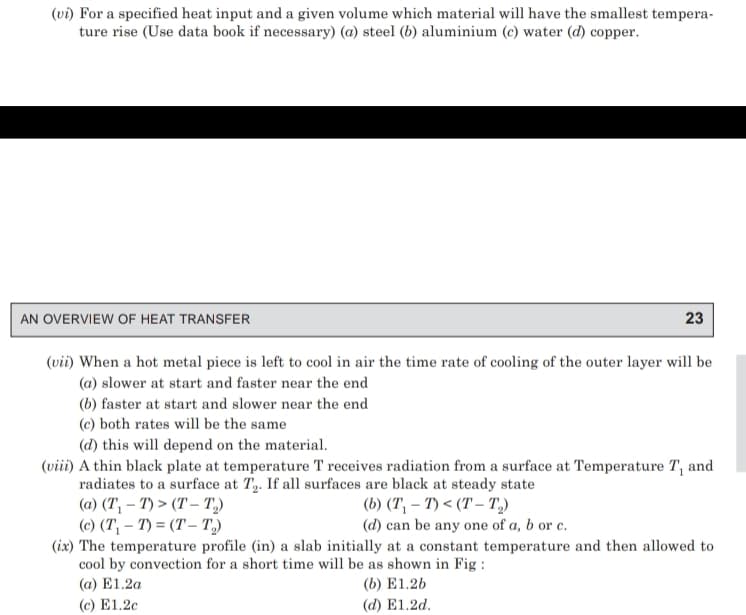or a specified heat input and a given volume which material will have the smallest tempera- ture rise (Use data book if necessary) (a) steel (b) aluminium (c) water (d) copper. When a hot metal piece is left to cool in air the time rate of cooling of the outer layer will be (a) slower at start and faster near the end (b) faster at start and slower near the end (c) both rates will be the same (d) this will depend on the material. (viii) A thin black plate at temperature T receives radiation from a surface at Temperature T1 and radiates to a surface at T2. If all surfaces are black at steady state (a) (T1 – T) > (T – T2) (b) (T1 – T) < (T – T2) (c) (T1 – T) = (T – T2) (d) can be any one of a, b or c. (ix) The temperature profile (in) a slab in
or a specified heat input and a given volume which material will have the smallest tempera- ture rise (Use data book if necessary) (a) steel (b) aluminium (c) water (d) copper. When a hot metal piece is left to cool in air the time rate of cooling of the outer layer will be (a) slower at start and faster near the end (b) faster at start and slower near the end (c) both rates will be the same (d) this will depend on the material. (viii) A thin black plate at temperature T receives radiation from a surface at Temperature T1 and radiates to a surface at T2. If all surfaces are black at steady state (a) (T1 – T) > (T – T2) (b) (T1 – T) < (T – T2) (c) (T1 – T) = (T – T2) (d) can be any one of a, b or c. (ix) The temperature profile (in) a slab in
Principles of Heat Transfer (Activate Learning with these NEW titles from Engineering!)
8th Edition
ISBN:9781305387102
Author:Kreith, Frank; Manglik, Raj M.
Publisher:Kreith, Frank; Manglik, Raj M.
Chapter1: Basic Modes Of Heat Transfer
Section: Chapter Questions
Problem 1.61P
Related questions
Question
100%
For a specified heat input and a given volume which material will have the smallest tempera-
ture rise (Use data book if necessary) (a) steel (b) aluminium (c) water (d) copper. When a hot metal piece is left to cool in air the time rate of cooling of the outer layer will be
(a) slower at start and faster near the end
(b) faster at start and slower near the end
(c) both rates will be the same
(d) this will depend on the material.
(viii) A thin black plate at temperature T receives radiation from a surface at Temperature T1 and
radiates to a surface at T2. If all surfaces are black at steady state
(a) (T1 – T) > (T – T2) (b) (T1 – T) < (T – T2)
(c) (T1 – T) = (T – T2) (d) can be any one of a, b or c.
(ix) The temperature profile (in) a slab initially at a constant temperature and then allowed to
cool by convection for a short time will be as shown in Fig :
(a) E1.2a (b) E1.2b
(c) E1.2c (d) E1.2d.
Ti

Transcribed Image Text:(vi) For a specified heat input and a given volume which material will have the smallest tempera-
ture rise (Use data book if necessary) (a) steel (b) aluminium (c) water (d) copper.
AN OVERVIEW OF HEAT TRANSFER
23
(vii) When a hot metal piece is left to cool in air the time rate of cooling of the outer layer will be
(a) slower at start and faster near the end
(b) faster at start and slower near the end
(c) both rates will be the same
(d) this will depend on the material.
(viii) A thin black plate at temperature T receives radiation from a surface at Temperature T, and
radiates to a surface at T,. If all surfaces are black at steady state
(a) (T, – T) > (T – T,)
(e) (T; – T) = (T – T,)
(ix) The temperature profile (in) a slab initially at a constant temperature and then allowed to
cool by convection for a short time will be as shown in Fig :
(b) (T, – T) < (T – T,)
(d) can be any one of a, b or c.
(a) E1.2a
(b) E1.26
(c) E1.2c
(d) E1.2d.
Expert Solution
This question has been solved!
Explore an expertly crafted, step-by-step solution for a thorough understanding of key concepts.
This is a popular solution!
Trending now
This is a popular solution!
Step by step
Solved in 3 steps

Knowledge Booster
Learn more about
Need a deep-dive on the concept behind this application? Look no further. Learn more about this topic, mechanical-engineering and related others by exploring similar questions and additional content below.Recommended textbooks for you

Principles of Heat Transfer (Activate Learning wi…
Mechanical Engineering
ISBN:
9781305387102
Author:
Kreith, Frank; Manglik, Raj M.
Publisher:
Cengage Learning

Principles of Heat Transfer (Activate Learning wi…
Mechanical Engineering
ISBN:
9781305387102
Author:
Kreith, Frank; Manglik, Raj M.
Publisher:
Cengage Learning